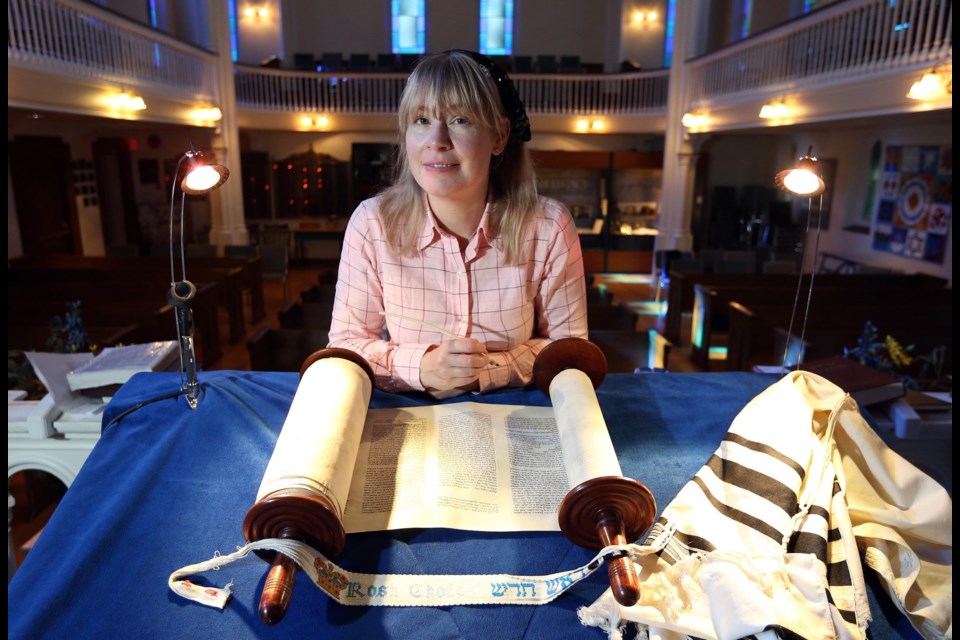When Congregation Emanu-El welcomes back its Torah scrolls on Sunday, it will also mark the return of a former Victoria woman who has expanded the centuries-old tradition of Hebrew calligraphy.
Avielah Barclay is a Hebrew ritual scribe, knowledgeable in the estimated 4,000 rules dedicated to producing and repairing kosher scrolls, hired to restore the Victoria synagogue’s Torah scrolls.
It’s a homecoming for Barclay, who lives in London with husband Marc Michaels, also a Jewish scribe, but she grew up largely in Victoria and attended Congregation Emanu-El.
“Victoria is really the hometown,” she said in an interview. “It’s a very special kind of place.”
Congregation Emanu-El, 1461 Blanshard St., this year is celebrating its 150th anniversary. It is the oldest synagogue in Western Canada and the oldest synagogue in continuous use in the country.
The congregation welcomes back its ritual scrolls Sunday with a special ceremony. Written on calves’ skin, in Hebrew, according to ancient traditions, the two scrolls contain the five books of Moses.
It will also be a return to the place where Barclay, 45, first felt the stirring of her avocation to become a ritual Hebrew scribe, until then undertaken traditionally by men.
Barclay said it was Jewish scholars and rabbis, first in Victoria and later in Vancouver, who delved into the notion of whether a woman could properly become a Hebrew scribe. After study and discussion, they decided there was no reason a woman could not and encouraged her to pursue it.
Barclay started her education in Jerusalem after finding a Jewish scribe, also known as a sofer, willing to mentor her.
Barclay learned she is not the first woman to take on the job, but believes she is the first in 250 years, “which is pretty good.”
She said she has heard of about 10 other women studying the intricate rules of making and repairing a kosher scroll.
“Maybe it will catch on,” Barclay said. “I think that’s even better for Jews and Jewish women and general equality. After all, we have the ability to learn the 4,000 rules of writing and repairing a kosher scroll and we have the artistic ability. Why not?”
Working on the scrolls and consulting with her husband, Barclay was also able to partly solve a mystery about the Victoria scrolls. It’s long been known they arrived in Victoria from San Francisco, believed to be carried there by a German Jew.
But looking at features such as stitching and thread-work, they realized the scrolls were at least 300 years old.
And by looking at the Hebrew letters on at least one of the scrolls, such as their designs and spacing, she concluded they are written in a German style, meaning they were likely produced in Germany.
But they are also written with distinctive European flourishes, a styling that almost disappeared with the Holocaust.
Barclay said these small markings add more than just decoration to the text. They act almost like “lecture notes” for reading the Torah.
“There are all kinds of stories and legends about why a letter is done in a particular way,” she said. “It allows you go that much deeper into the text.
“It’s one thing to learn Biblical Hebrew,” she said, “but it’s a whole new thing to learn all these little extrapolations.”
Rabbi Harry Brechner said when the scrolls are ritually put back in their place at Congregation Emanu-El, he plans to celebrate the reunion of the synagogue and its scrolls like a wedding.
The synagogue has a new wedding canopy, or chuppah, which will be carried over the scrolls. A small parade will carry the scrolls back to their special place in the east wall of the synagogue.
“We really see it as a wedding, as a union between people and the divine source,” Brechner said.
Members of the congregation will take a hand in writing some of the last lines of the Torah, deliberately left unfinished so the congregation can play its human part in the scrolls’ preservation.
Brechner said the most important thing about the scrolls is what they contain. After all, when studying the Torah and teaching Hebrew, the congregation uses books or even photocopies.
But because of the scrolls’ connections to history, tradition and divine inspiration, they are always regarded with awe.
“They are something that is very much venerated and loved,” Brechner said. “When we take them out we’ll do a procession and people will reach out and touch them or kiss them. There is a lot of honour and love given to the scrolls.”
A ceremonial parade to return the scrolls to Congregation Emanu-El begins at 10 a.m. Sunday on Pandora Avenue near Vancouver Street.
All members of the community are welcome.



